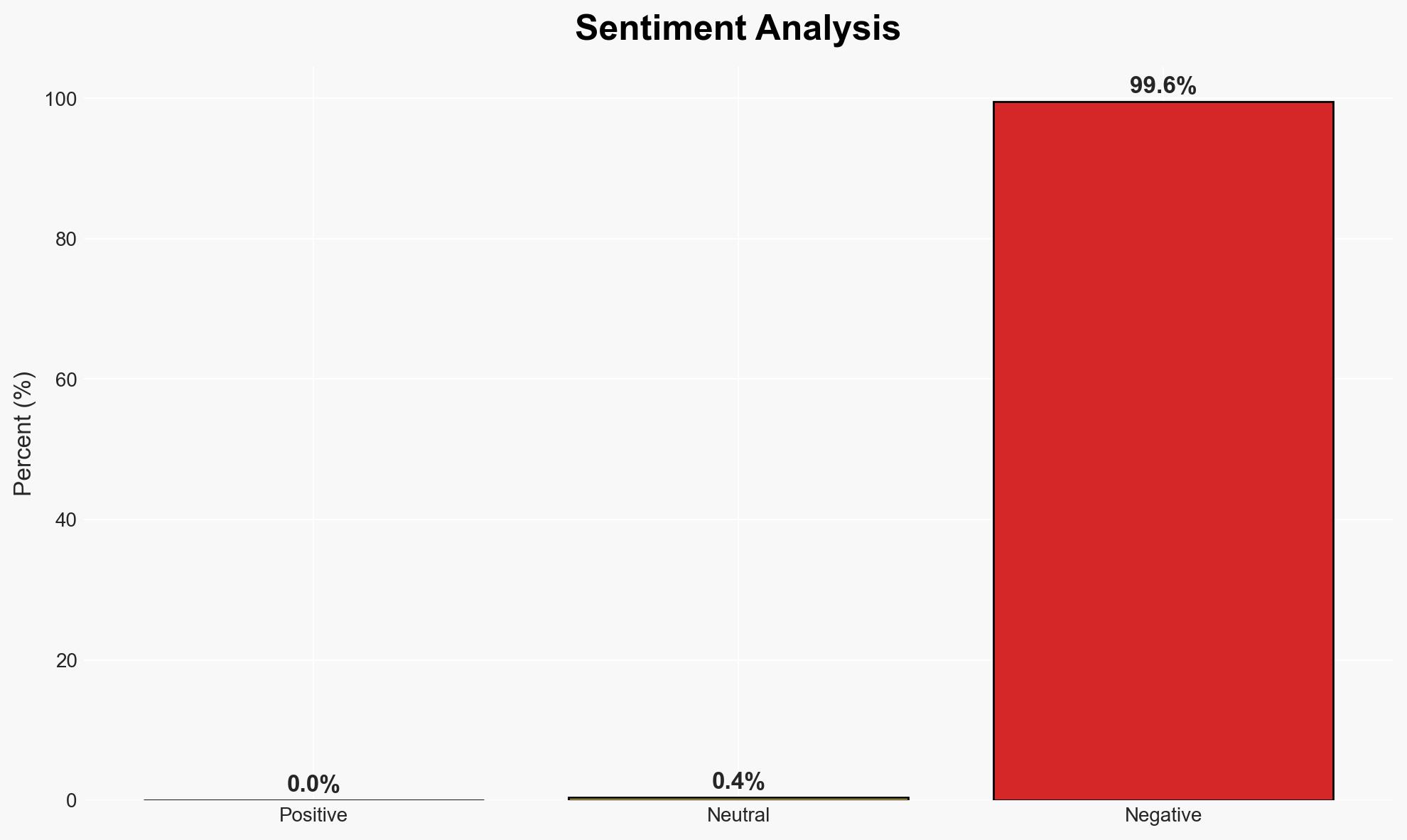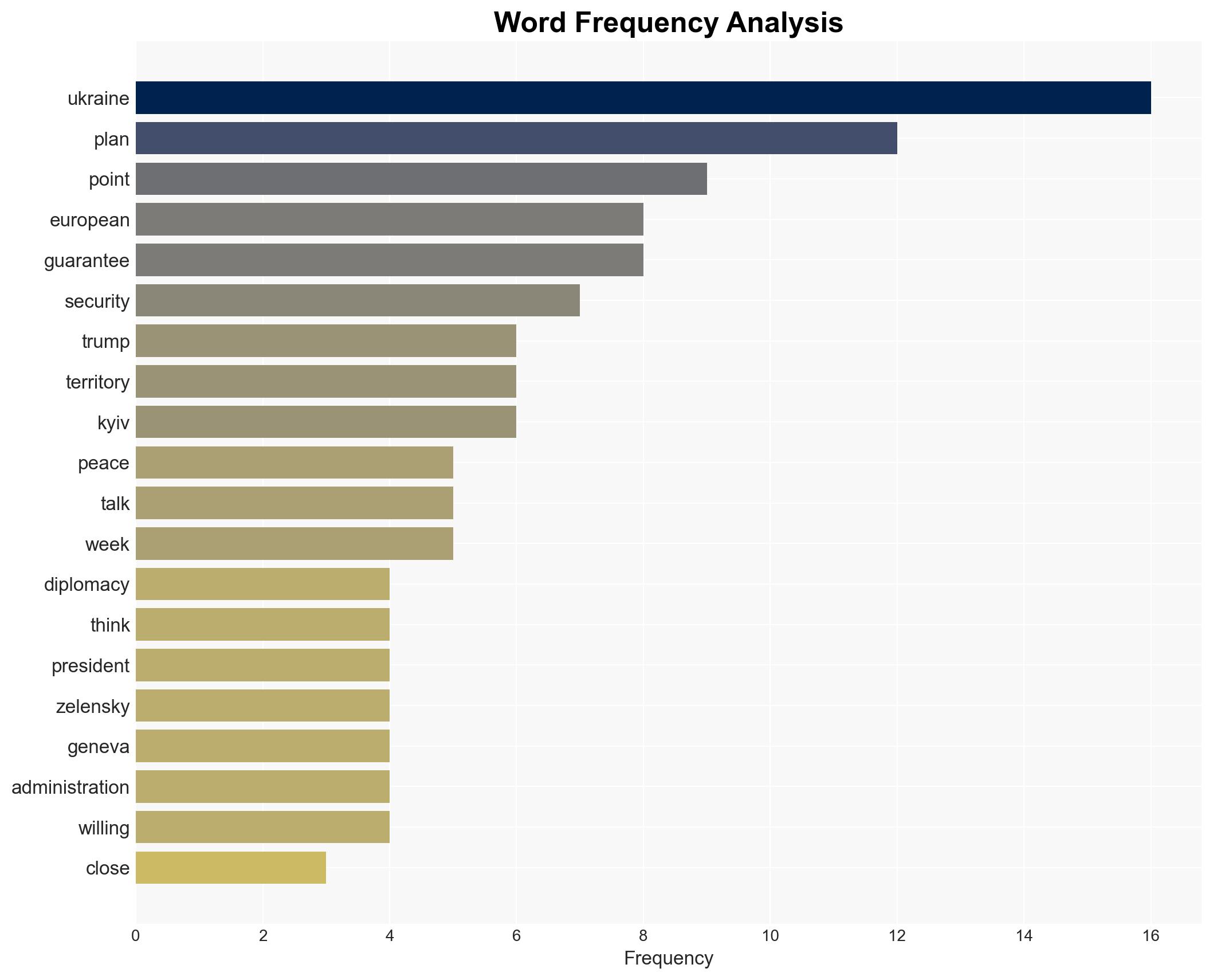Current Status of Peace Efforts in Ukraine Amidst Intense Diplomatic Activity
Published on: 2025-11-26
AI-powered OSINT brief from verified open sources. Automated NLP signal extraction with human verification. See our Methodology and Why WorldWideWatchers.
Intelligence Report: Where peace stands in Ukraine after frantic diplomacy
1. BLUF (Bottom Line Up Front)
The current diplomatic efforts to secure peace in Ukraine face significant obstacles, with no immediate resolution in sight. The most likely hypothesis is that negotiations will continue to be protracted due to fundamental disagreements over territorial concessions and security guarantees. This situation affects Ukraine, Russia, and European stakeholders, with moderate confidence in this assessment.
2. Competing Hypotheses
- Hypothesis A: Diplomatic negotiations will lead to a peace agreement in the near term. Supporting evidence includes ongoing high-level discussions and the involvement of key international players. Contradicting evidence includes the significant gaps on critical issues such as territory and NATO membership.
- Hypothesis B: Diplomatic efforts will stall, and no agreement will be reached soon. This is supported by the entrenched positions of Ukraine and Russia, particularly on territorial concessions and security guarantees. The lack of consensus among European leaders further supports this hypothesis.
- Assessment: Hypothesis B is currently better supported due to the deep-rooted disagreements and the absence of a clear path to compromise. Key indicators that could shift this judgment include a change in the stance of either Ukraine or Russia on key issues or increased pressure from international actors.
3. Key Assumptions and Red Flags
- Assumptions: The parties involved are negotiating in good faith; international stakeholders will continue to exert pressure for a resolution; the current geopolitical climate remains stable.
- Information Gaps: Details of the latest negotiation proposals and the specific positions of key stakeholders are unclear. The full extent of European involvement and influence is also uncertain.
- Bias & Deception Risks: Potential bias in reporting from involved parties; risk of strategic deception by Russia or other stakeholders to gain leverage in negotiations.
4. Implications and Strategic Risks
The ongoing diplomatic efforts, if unresolved, could lead to prolonged instability in the region, affecting broader geopolitical dynamics.
- Political / Geopolitical: Potential escalation of tensions between Russia and NATO; increased pressure on European unity and policy coherence.
- Security / Counter-Terrorism: Continued military posturing and potential for localized conflicts; risk of increased terrorist activities exploiting instability.
- Cyber / Information Space: Heightened cyber operations targeting critical infrastructure; information warfare to influence public perception and diplomatic outcomes.
- Economic / Social: Economic strain on Ukraine and neighboring countries; potential for social unrest due to prolonged conflict and economic hardship.
5. Recommendations and Outlook
- Immediate Actions (0–30 days): Increase intelligence collection on negotiation dynamics; engage in diplomatic backchannels to facilitate dialogue; monitor for signs of escalation.
- Medium-Term Posture (1–12 months): Strengthen alliances and partnerships in the region; enhance cybersecurity defenses; prepare contingency plans for potential conflict scenarios.
- Scenario Outlook:
- Best Case: A comprehensive peace agreement is reached, stabilizing the region.
- Worst Case: Diplomatic failure leads to renewed hostilities and regional destabilization.
- Most Likely: Protracted negotiations with intermittent progress and setbacks.
6. Key Individuals and Entities
- Volodymyr Zelensky (Ukraine’s President)
- Vladimir Putin (Russia’s President)
- Yuri Ushakov (Kremlin Aide)
- Dmitry Peskov (Putin’s Spokesman)
- Donald Trump (Former U.S. President)
- Dan Driscoll (Army Secretary)
- Steve Witkoff (Trump’s Envoy)
- Myroslava Gongadze (Nonresident Senior Fellow, Atlantic Council Eurasia Center)
7. Thematic Tags
Regional Focus, This brief is tagged under: national security threats; cybersecurity; counter-terrorism; regional focus. Additional tags include: diplomatic negotiations, geopolitical tensions, military strategy, and international relations
Structured Analytic Techniques Applied
- Causal Layered Analysis (CLA): Analyze events across surface happenings, systems, worldviews, and myths.
- Cross-Impact Simulation: Model ripple effects across neighboring states, conflicts, or economic dependencies.
- Scenario Generation: Explore divergent futures under varying assumptions to identify plausible paths.
- Narrative Pattern Analysis: Deconstruct and track propaganda or influence narratives.
Explore more:
Regional Focus Briefs ·
Daily Summary ·
Support us





